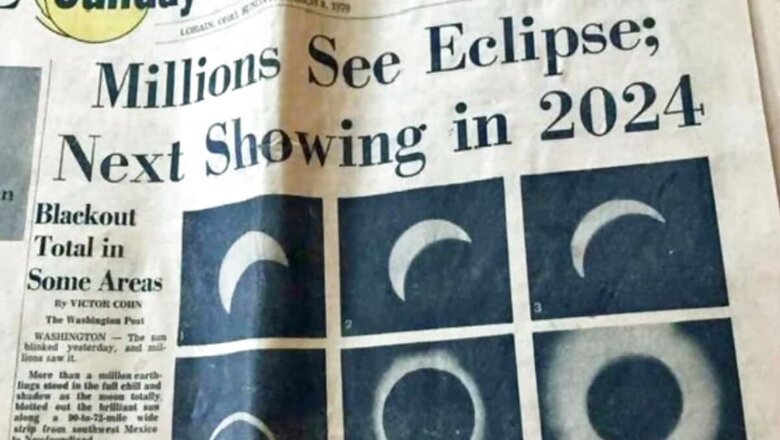
views
A photo of an Ohio newspaper from 1970 predicting the upcoming total solar eclipse is raking in likes on X. The newspaper headline says, “Millions See Eclipse, Next Showing in 2024.” Even though the exact date of the newspaper is hard to tell, but it appears that the paper was first referring to the total solar eclipse that occurred on March 7, 1970. It was visible across North America and Central America. The upcoming total solar eclipse will occur on April 8. It will be visible over North America, Mexico and Canada. The total solar eclipse is estimated to last up to 4 minutes and 28 seconds in the path of total darkness.
A total solar eclipse occurs when the Moon comes in between the Sun and Earth and completely blocks the face of the Sun. This darkens the sky and the day appears like dusk for some time. Total solar eclipses are rare compared to partial or annular solar eclipses. According to Space.com, the next total solar eclipse will be on August 12, 2026. It will be visible from Greenland, Iceland, and the Atlantic Ocean.
Ohio newspaper from 1970 forecasting this year’s April 8 solar eclipse. [???? u/Fleegle1834] pic.twitter.com/KpMpT9kYUT
— Massimo (@Rainmaker1973) March 19, 2024
Commenting on the Ohio newspaper’s forecasting, an X user wrote, “Fascinating to see predictions of celestial events from the past. It reminds us of the awe-inspiring nature of the universe and our place within it. Science and history intertwined in a single newspaper page.”
Fascinating to see predictions of celestial events from the past. It reminds us of the awe-inspiring nature of the universe and our place within it. Science and history intertwined in a single newspaper page.— Muhmmad Azhar (@AzharTheGreat) March 19, 2024
Another person wrote, “A 2024 Solar Eclipse forecast made in 1970. Interesting. I can imagine some of those old people who read the newspaper then saying: 2024, that’s a long time to come! Would the world still be existing by then?”
A 2024 Solar Eclipse forecast made in 1970. Interesting. I can imagine some of those old people who read the newspaper then saying: "2024, that's a long time to come! Would the world still be existing by then?"'— Booost ⚡️ (@Booostofficial) March 19, 2024
Science and space enthusiasts are gearing up to witness the total solar eclipse and are planning eclipse-watching events. Meanwhile, government and space research organisations are alerting people to take appropriate precautions while watching the total eclipse.
People must wear specialised eclipse glasses while looking at the sun during the eclipse. According to NASA, except for a short time when the moon completely blocks the sun, it is not safe to “look directly at the Sun without specialized eye protection”. NASA also warns of getting “instant and severe eye injury” if one views the sun “through a camera lens, binoculars, or a telescope without a special-purpose solar filter secured over the front of the optics”. Often people confuse the eclipse glasses with regular sunglasses, however, the special eclipse glasses are “thousands of times darker and comply with the ISO 12312-2 international standard”.


















Comments
0 comment